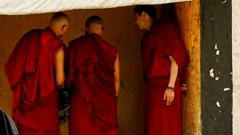The recent 90th birthday celebration of the Dalai Lama highlights the stark realities for Tibetans residing in their homeland. The Kirti monastery, a historical center of resistance located in Aba, Sichuan province, remains a focal point for the Tibetan struggle against Chinese oppression. Despite the oppressive atmosphere marked by relentless surveillance and heavy security presence, local monks are wary yet willing to share their sentiments about the current conditions.
Amid crimson robes and rhythmic prayer beads, a monk reflected on the bleak situation: “Things here are not good for us.” Unfortunately, as we ventured deeper into discussions about their plight, we were subjected to the ominous presence of eight unidentified individuals shadowing our every move—evidence of the government's iron grip on information and freedom of expression.
The monastery rose to world attention during the late 2000s, witnessing acts of self-immolation by Tibetans protesting against Chinese governance. Even now, the heightened police presence—including a newly constructed station at the entrance—underscores the fears and freedoms that Tibetan people have lost. The monk's warning, “Be careful, people are watching you,” serves as a reminder of the pervasive scrutiny faced by those who dare to express dissent.
Having integrated Tibet into its territorial framework, China sees the region not only as a part of its compendium but has also invested heavily in infrastructure, claiming to enhance development and tourism. However, many Tibetans argue that these advancements come at the cost of their fundamental rights and cultural essence. They contend that increased economic presence correlates with a rise in military and bureaucratic control, as explicit recognition of the Dalai Lama's image can lead to imprisonment.
In the aftermath of the Dalai Lama announcing plans for his succession, the atmosphere in Tibet is remarkably tense yet muted. The Dalai Lama, revered by Tibetans globally, reinforced that the next leader would not be identified until after his death, igniting mixed feelings of hope, worry, and skepticism among his followers. Yet, those within Tibet face a chilling silence, as speaking or even whispering the Dalai Lama’s name can lead to severe consequences.
Tibetan communities outside China—including Dharamshala, India—enthusiastically gathered to celebrate their spiritual leader. Yet, in marked contrast, the silence within Tibet reveals an unyielding repression. The Chinese Communist Party has expressed a clear intention to control the forthcoming succession, stating that the next Dalai Lama must comply with Chinese regulations, a challenge that defies Tibetan cultural practices and beliefs.
Encapsulated in their tradition and faith, Tibetans face an existential challenge where modern laws dictate their education and religious practices. New requirements mandating that children be educated in state-run schools rather than traditional monastic systems threaten the survival of their cultural identity. Tibetan children must learn Mandarin and state-approved values, signaling an encroachment on the Tibetan way of life.
As visitors and tourists flock to Aba with newfound interest and curiosity, the daily life of Tibetan monks continues to navigate a precarious balance between faith, identity, and oppression. Tensions mounted over years of resentment towards Beijing's governance pose a daunting question: how much longer can these traditions endure?
Ultimately, the coming years will determine the fate of Tibetan Buddhism and its deep-rooted cultural legacy, especially as the Dalai Lama embodies a journey towards freedom and affirmation of identity. As they persist in their quiet resistance beneath China's watchful eyes, Tibetans confront an uncertain future in their homeland, further complicating their fight for recognition and autonomy.



















